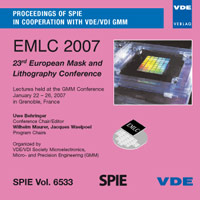Current status of water immersion lithography and prospect of higher index method
Konferenz: EMLC 2007 - 23rd European Mask and Lithography Conference
22.01.2007 - 26.01.2007 in Grenoble, France
Tagungsband: EMLC 2007
Seiten: 5Sprache: EnglischTyp: PDF
Persönliche VDE-Mitglieder erhalten auf diesen Artikel 10% Rabatt
Autoren:
Owa, Soichi; Nakano, Katsushi; Nagasaka, Hiroyuki; Kohno, Hirotaka; Ohmura, Yasuhiro (Nikon Corporation, 201-9, Miizugahara, Kumagaya, Saitama, 360-8559, Japan)
McCallum, Martin (Nikon Precision Europe GmbH, Appleton Place, Appleton Parkway, Livingston, EH54 7EZ, UK)
Inhalt:
In this paper we will present the progress that has been made in the area of tool development for ArF Immersion. The local fill nozzle design adopted by Nikon has been implemented in the world’s first production Immersion tools, the S609B and S610C, to produce bubble free and low defect imaging. Defect, imaging and overlay results from the S609B are presented showing manufacturing level results. First imaging results from the 1.30 NA S610C are also reported showing the tools capability to image at the 45nm node and beyond. Beyond 1.30 NA it is likely that high index materials will be required. We examine the prospects for taking immersion to lens NA’s of around 1.55 with second generation fluids and even 1.70 NA with third generation fluids. However, it cannot be forgotten that this also requires new glass materials for lenses; the status of these will also be discussed. It is likely that high index immersion, if implemented, will not be in time for most customers’ roadmaps, in the interim it is likely that Double Patterning (DP) will be used with potential cost penalites. The potential applications of this technique will be briefly discussed.


